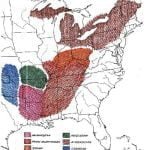The Algonquian tribes are believed to have come from the far northwest and to have skirted the shores of the Great Lakes before reaching the country farther south. At their first coming, long before the Iroquoian peoples had arrived in the regions south of the St. Lawrence, some tribes of the Algonquian stock appear to have penetrated far south along the mountains into Tennessee or beyond, while others pushed onward into the Piedmont sections of the present Virginia and of the Carolinas. Certain stone implements or weapons found in these regions reveal great age and are readily distinguished from others that were undoubtedly made and used by the later historic of the same regions. These older specimens were evidently made during the early period of occupancy, during which time tile numerous soapstone quarries were probably opened and worked.
The explorations conducted by M. R. Harrington in London County, Tennessee, during the summer and autumn of 1919, resulted in the discovery of evidence of very early tribes in the upper valley of the Tennessee. Traces of three distinct periods of occupancy were recognized. The earliest was termed that of the ”Round Grave people ” by reason of the characteristic form of burial encountered. The objects of stone and types of pottery vessels attributed to this early period resemble similar material found from New England southward to Virginia. The extensive use of soapstone in the same localities is another important similarity.” It thus seems logical to state that our ‘Round Grave people’ were either Algonkians closely related to those of the Middle Atlantic slope, or had at least been profoundly influenced by them.” 1 Possibly one or more of the proto-Muskhogean tribes followed the “Round Grave people”, and these in turn may have been succeeded by the Cherokee, who continued to occupy the region in historic times.

The earlier wave of Algonquian tribes into the south probably receded before the approach of the Siouan and other peoples coming from the west or southwest. The connection between these early tribes and the inhabitants of tidewater Virginia at the beginning of the seventeenth century may have been very slight.
Although the Algonquian tribes came from the northwest, all other native peoples encountered east of the Mississippi are generally thought to have migrated from the west or southwest. These coming from their earlier habitat arrived on the right bank of the Mississippi, probably southward from the vicinity of the mouth of the Arkansas River; thence, having crossed to the eastern side, they became widely dispersed throughout the river valleys, pinelands, and mountain ranges.
The first movements of the native peoples into the country eastward from the Mississippi, those from whom some of the historic tribes have descended, probably occurred at an earlier time than usually conceded. They may have been the true aborigines of the southeastern country, for as yet no indisputable evidence of Pleistocene man has been discovered in any locality betweent the Mississippi River and the Atlantic coast.
The languages of all the peoples of the southeastern section, with the exception of the Iroquoian and the smaller Algonquian groups, show structural similarities that suggest a very early contact or association of the various tribes, obviously in a region west of the Mississippi before their removal eastward. The numerous tribes appear to have entered the trans Mississippi country in successive waves, the movements continuing through centuries.
The Uchean and Siouan groups were probably among the earliest to arrive on the left bank of the Mississippi and, belonging to the same early period, may have been the ancestors of the Natchez, who did not move far eastward, and also of the Timucua tribes and of the little known Calusa, who at the beginning of the historic era occupied many villages on the peninsula of Florida. Undoubtedly, others joined in the early movements, but their identity will never be revealed. The various tribes just mentioned will be considered and referred to in this sketch as the proto-Muskhogean groups; however, the Uchean and Siouan peoples will be traced separately on the maps.
It is evident that the Siouan tribes, and others who may have been allied with them, after crossing to the left bank of the Mississippi, continued their advance into the valley of the Ohio. The majority are believed to have settled north of the river and to have developed the remarkable cultures that have been revealed in recent years. All did not cross the Ohio; some remained south of the stream and continued eastward into the mountainous country, and these probably constituted the southeastern group of Swanton’s classification, as mentioned later in this article.
Citations:
- Harrington, M. R., Cherokee and earlier remains on Upper Tennessee River, p. 167. Museum of the American Indian, New York, 1922.[
]
